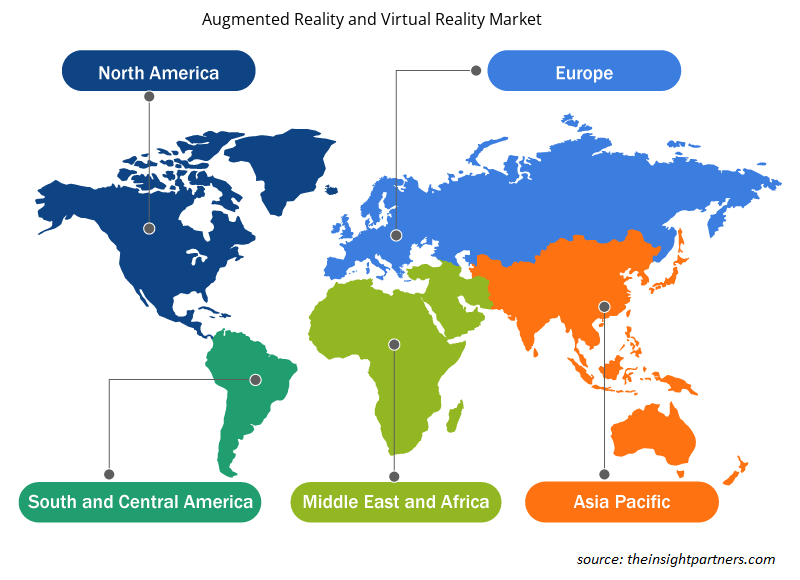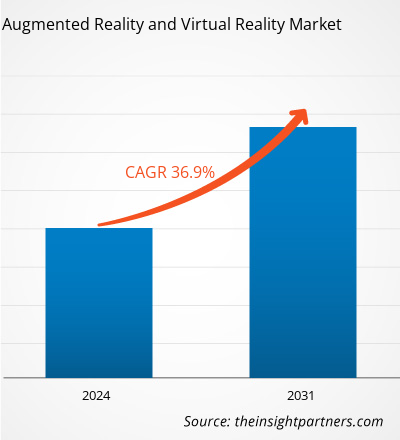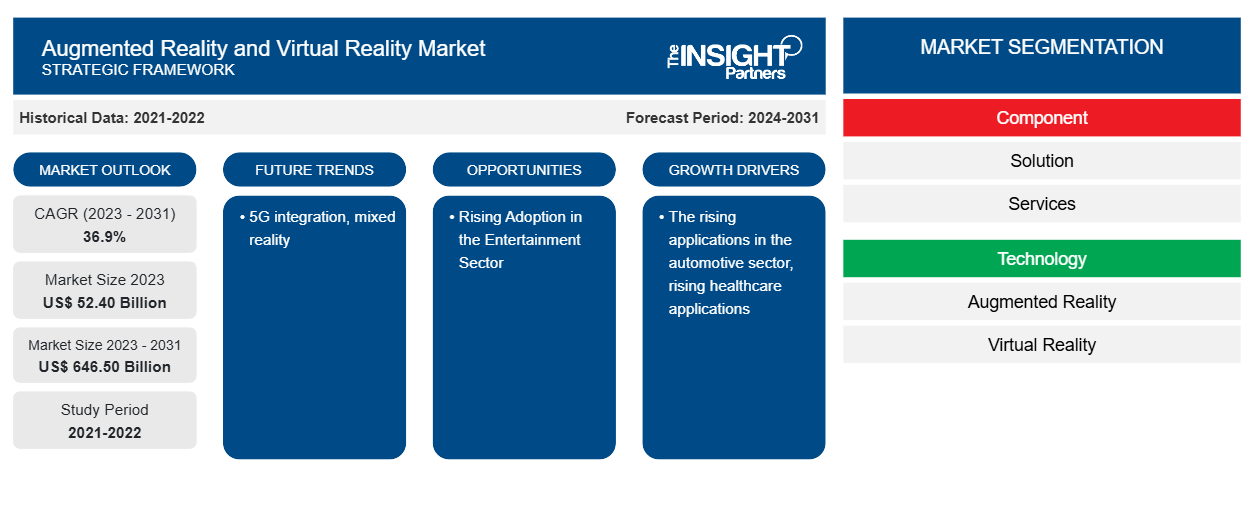Se proyecta que el tamaño del mercado de realidad aumentada y realidad virtual alcance los 646,50 mil millones de dólares estadounidenses para 2031, desde los 52,40 mil millones de dólares estadounidenses en 2023. Se espera que el mercado registre una CAGR del 36,9 % durante 2023-2031. Es probable que la integración 5G y la realidad mixta sigan siendo tendencias clave en el mercado.
Análisis del mercado de realidad aumentada y realidad virtual
La tecnología de realidad aumentada y realidad virtual ofrece numerosas oportunidades únicas tanto para las empresas nuevas como para las ya establecidas y para el comercio. La tecnología de realidad aumentada permite a las personas de numerosas profesiones ver gráficos generados por computadora en su campo de visión. Ambas tecnologías se utilizan ampliamente en varias industrias, entre ellas la atención médica, los medios de comunicación, el gas y el petróleo, el turismo, la educación, los juegos, el entretenimiento, el ejército, el marketing, el comercio electrónico y la venta minorista.
Panorama del mercado de realidad aumentada y realidad virtual
La industria global de AR y VR está experimentando una rápida expansión debido a la mayor demanda de dispositivos móviles y las inversiones en I+D. La tecnología AR/VR tiene poca demanda y adopción en comparación con otros dispositivos de consumo debido a su alto costo e impacto visual. Las principales corporaciones tecnológicas multinacionales están invirtiendo en investigación y desarrollo de VR/AR para avanzar en la tecnología.
Personalice este informe según sus necesidades
Obtendrá personalización en cualquier informe, sin cargo, incluidas partes de este informe o análisis a nivel de país, paquete de datos de Excel, así como también grandes ofertas y descuentos para empresas emergentes y universidades.
-
Obtenga las principales tendencias clave del mercado de este informe.Esta muestra GRATUITA incluirá análisis de datos, desde tendencias del mercado hasta estimaciones y pronósticos.
Impulsores y oportunidades del mercado de la realidad aumentada y la realidad virtual
Las crecientes solicitudes en el sector de la automoción favorecen al mercado
La realidad aumentada y virtual en la industria automotriz se está convirtiendo cada vez más en un estándar debido a las numerosas aplicaciones y beneficios que ofrece. Simplifica y mejora la compra de vehículos y la experiencia de conducción para todas las partes involucradas. La industria automotriz está adoptando agresivamente la realidad aumentada y virtual para mejorar las experiencias de conducción y de vacaciones. De hecho, entre todos los sectores principales, el sector automotriz es el que más ha invertido en tecnologías de realidad aumentada y virtual. Algunos pesos pesados de la industria, como Porsche, Chrysler, Hyundai, Mitsubishi y Tesla, ya han integrado las dos tecnologías en varias etapas de producción, comercialización y ventas de vehículos. Esto está impulsando la demanda en el mercado de realidad aumentada y realidad virtual.
La creciente adopción en el sector del entretenimiento
El sector del entretenimiento de realidad virtual ha tenido un impacto significativo en la forma en que los consumidores consumen medios, provocando un cambio de paradigma en todo, desde los videojuegos hasta las películas, los espectáculos en vivo y las experiencias en los parques de diversiones. La tecnología VR/AR (Realidad Virtual/Realidad Aumentada) ya está comenzando a tener un impacto en la transmisión y el streaming de medios. La transmisión y el streaming de VR/AR pueden proporcionar a los espectadores una experiencia totalmente inmersiva, permitiéndoles interactuar con el material de formas nuevas e intrigantes. Esta tecnología puede utilizarse para producir experiencias cautivadoras, como películas de 360 grados, cobertura deportiva interactiva, eventos musicales de realidad virtual y mucho más.
Análisis de segmentación del informe de mercado de realidad aumentada y realidad virtual
Los segmentos clave que contribuyeron a la derivación del análisis del mercado de realidad aumentada y realidad virtual son la industria de tecnología, componentes y usuario final.
- Según la tecnología, el mercado de realidad aumentada y realidad virtual se divide en realidad aumentada y realidad virtual. El segmento de realidad aumentada tuvo una mayor participación de mercado en 2023.
- Por componente, el mercado está segmentado en componentes semiconductores directos, sensores y otros.
- Por industria de usuario final, el mercado está segmentado en entretenimiento, educativo, industrial, médico, inmobiliario y arquitectura, minorista, aeroespacial y defensa, y otros.
Análisis de la cuota de mercado de la realidad aumentada y la realidad virtual por geografía
El alcance geográfico del informe de mercado de realidad aumentada y realidad virtual se divide principalmente en cinco regiones: América del Norte, Asia Pacífico, Europa, Medio Oriente y África, y América del Sur y Central.
América del Norte dominó la participación de mercado de la realidad aumentada y la realidad virtual en 2023. La región cuenta con países como Estados Unidos y Canadá, que son tecnológicamente avanzados. El panorama de las empresas emergentes en Estados Unidos está en constante evolución y los actores emergentes están logrando avances en tecnologías de realidad aumentada y realidad virtual de vanguardia.
Perspectivas regionales del mercado de realidad aumentada y realidad virtual
Los analistas de Insight Partners explicaron en detalle las tendencias y los factores regionales que influyen en el mercado de realidad aumentada y realidad virtual durante el período de pronóstico. Esta sección también analiza los segmentos y la geografía del mercado de realidad aumentada y realidad virtual en América del Norte, Europa, Asia Pacífico, Oriente Medio y África, y América del Sur y Central.

- Obtenga datos regionales específicos para el mercado de realidad aumentada y realidad virtual
Alcance del informe de mercado de realidad aumentada y realidad virtual
| Atributo del informe | Detalles |
|---|---|
| Tamaño del mercado en 2023 | US$ 52,40 mil millones |
| Tamaño del mercado en 2031 | US$ 646,50 mil millones |
| CAGR global (2023 - 2031) | 36,9% |
| Datos históricos | 2021-2022 |
| Período de pronóstico | 2024-2031 |
| Segmentos cubiertos |
Por componente
|
| Regiones y países cubiertos |
América del norte
|
| Líderes del mercado y perfiles de empresas clave |
|
Densidad de actores del mercado de realidad aumentada y realidad virtual: comprensión de su impacto en la dinámica empresarial
El mercado de la realidad aumentada y la realidad virtual está creciendo rápidamente, impulsado por la creciente demanda de los usuarios finales debido a factores como la evolución de las preferencias de los consumidores, los avances tecnológicos y una mayor conciencia de los beneficios del producto. A medida que aumenta la demanda, las empresas amplían sus ofertas, innovan para satisfacer las necesidades de los consumidores y aprovechan las tendencias emergentes, lo que impulsa aún más el crecimiento del mercado.
La densidad de actores del mercado se refiere a la distribución de las empresas o firmas que operan dentro de un mercado o industria en particular. Indica cuántos competidores (actores del mercado) están presentes en un espacio de mercado determinado en relación con su tamaño o valor total de mercado.
Las principales empresas que operan en el mercado de Realidad Aumentada y Realidad Virtual son:
- Mirada inmersiva
- Google LLC
- Realidad EON
- Corporación Vuzix
- Blippar Group Limited (Layar BV)
- Innovega Inc.
Descargo de responsabilidad : Las empresas enumeradas anteriormente no están clasificadas en ningún orden particular.

- Obtenga una descripción general de los principales actores clave del mercado de realidad aumentada y realidad virtual
Noticias y desarrollos recientes del mercado de realidad aumentada y realidad virtual
El mercado de la realidad aumentada y la realidad virtual se evalúa mediante la recopilación de datos cualitativos y cuantitativos a partir de investigaciones primarias y secundarias, que incluyen publicaciones corporativas importantes, datos de asociaciones y bases de datos. A continuación, se enumeran algunos de los avances en el mercado de la realidad aumentada y la realidad virtual:
- EON Reality anuncia con orgullo el lanzamiento del primer Centro de IA Espacial en las Islas Marshall. Esta iniciativa fundamental transformará el enfoque de las islas en materia de educación, atención médica y resiliencia climática, implementando tecnologías inmersivas para ser pioneras en experiencias de aprendizaje avanzadas y desarrollo sostenible. (Fuente: EON Reality, comunicado de prensa, abril de 2024)
- Vuzix® Corporation (NASDAQ: VUZI) anunció que recibió nuevos pedidos adicionales de dos empresas aeroespaciales y de defensa para seguir desarrollando y entregando soluciones de visualización basadas en guías de ondas en 2024. (Fuente: Vuzix Corporation, comunicado de prensa, abril de 2024)
Informe sobre el mercado de realidad aumentada y realidad virtual: cobertura y resultados
El informe “Tamaño y pronóstico del mercado de realidad aumentada y realidad virtual (2021-2031)” proporciona un análisis detallado del mercado que cubre las siguientes áreas:
- Tamaño y pronóstico del mercado de realidad aumentada y realidad virtual a nivel global, regional y nacional para todos los segmentos clave del mercado cubiertos bajo el alcance
- Tendencias del mercado de realidad aumentada y realidad virtual, así como dinámica del mercado, como impulsores, restricciones y oportunidades clave
- Análisis detallado de las cinco fuerzas de Porter y PEST y FODA
- Análisis del mercado de realidad aumentada y realidad virtual que cubre las tendencias clave del mercado, el marco global y regional, los principales actores, las regulaciones y los desarrollos recientes del mercado.
- Panorama de la industria y análisis de la competencia que abarca la concentración del mercado, análisis de mapas de calor, actores destacados y desarrollos recientes para el mercado de realidad aumentada y realidad virtual
- Perfiles detallados de empresas
- Análisis histórico (2 años), año base, pronóstico (7 años) con CAGR
- Análisis PEST y FODA
- Tamaño del mercado, valor/volumen: global, regional y nacional
- Industria y panorama competitivo
- Conjunto de datos de Excel
Informes recientes
Testimonios
Razón para comprar
- Toma de decisiones informada
- Comprensión de la dinámica del mercado
- Análisis competitivo
- Información sobre clientes
- Pronósticos del mercado
- Mitigación de riesgos
- Planificación estratégica
- Justificación de la inversión
- Identificación de mercados emergentes
- Mejora de las estrategias de marketing
- Impulso de la eficiencia operativa
- Alineación con las tendencias regulatorias























 Obtenga una muestra gratuita para - Mercado de realidad aumentada y realidad virtual
Obtenga una muestra gratuita para - Mercado de realidad aumentada y realidad virtual